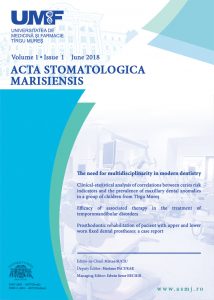Introduction. It is well known that previously has been demonstrated a correlation between respiratory function and the harmonious craniofacial development and head posture respectively.
Aim of the study. The purpose of this study was to investigate the correlation between rapid maxillary expansion (RME) and the change in natural head position (NHP) resulting from the consequent change in airway resistance and to elucidate how RME influences NHP in terms of cephalometric angles in children with nasal obstruction.
Material and methods. The study included 12 girls and 8 boys who had a history of mouth breathing, as confirmed by the parents and ORL specialist and due to this fact, they underwent RME as part of orthodontic treatment. Dental casts, clinical photographs and lateral skull radiographs exposed in natural head position were obtained at the first visit (T1) and 8-10 months (T2) later for all subjects. In order to evaluate the patient’s lateral skull radiographs, I used AudaxCeph software, within which I created a new type of analysis. Student T test and Pearson correlation test were used to statistically analyze the results.
Results. Our findings demonstrate that no significant changes in any of the variables are observed in patients treated with rapid maxillary expansion, however a positive correlation was observed in the variables measured before and after the treatment, respectively between the anomaly and the measured values. Positivity can also be detected when examining the correlation between the patient’s gender and the measured values.
Conclusions. Based on the obtained results, we cannot state that there is a correlation between rapid maxillary expansion and cervical posture.
Silvia Izabella Pop 1, Martha Krisztina 1, Laura Roxana Contac 1, Sandor Henrietta 1
1 George Emil Palade University of Medicine, Pharmacy, Science, and Technology of Târgu-Mureș, Romania
1 George Emil Palade University of Medicine, Pharmacy, Science, and Technology of Târgu-Mureș, Romania

Comments are closed.